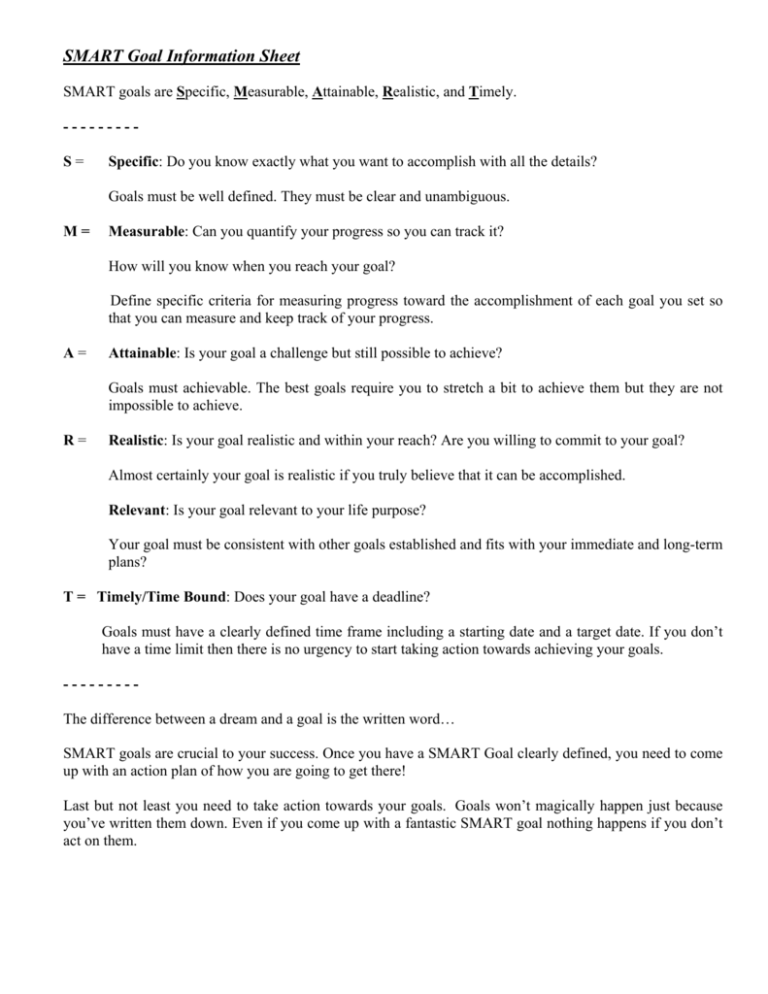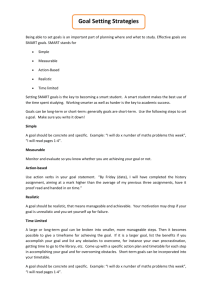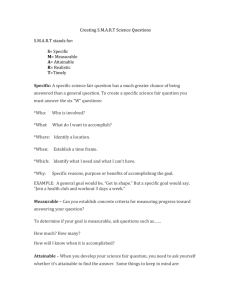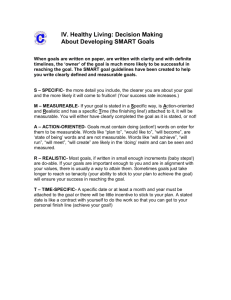SMART Goal Information Sheet
advertisement

SMART Goal Information Sheet SMART goals are Specific, Measurable, Attainable, Realistic, and Timely. --------S= Specific: Do you know exactly what you want to accomplish with all the details? Goals must be well defined. They must be clear and unambiguous. M= Measurable: Can you quantify your progress so you can track it? How will you know when you reach your goal? Define specific criteria for measuring progress toward the accomplishment of each goal you set so that you can measure and keep track of your progress. A= Attainable: Is your goal a challenge but still possible to achieve? Goals must achievable. The best goals require you to stretch a bit to achieve them but they are not impossible to achieve. R= Realistic: Is your goal realistic and within your reach? Are you willing to commit to your goal? Almost certainly your goal is realistic if you truly believe that it can be accomplished. Relevant: Is your goal relevant to your life purpose? Your goal must be consistent with other goals established and fits with your immediate and long-term plans? T = Timely/Time Bound: Does your goal have a deadline? Goals must have a clearly defined time frame including a starting date and a target date. If you don’t have a time limit then there is no urgency to start taking action towards achieving your goals. --------The difference between a dream and a goal is the written word… SMART goals are crucial to your success. Once you have a SMART Goal clearly defined, you need to come up with an action plan of how you are going to get there! Last but not least you need to take action towards your goals. Goals won’t magically happen just because you’ve written them down. Even if you come up with a fantastic SMART goal nothing happens if you don’t act on them. Specific - A specific goal has a much greater chance of being accomplished than a general goal. To set a specific goal you must answer the six "W" questions: *Who: Who is involved? *What: What do I want to accomplish? *Where: Identify a location. *When: Establish a time frame. *Which: Identify requirements and constraints. *Why: Specific reasons, purpose or benefits of accomplishing the goal. EXAMPLE: A general goal would be, "Get in shape." But a specific goal would say, "Join a health club and workout 3 days a week." Measurable - Establish concrete criteria for measuring progress toward the attainment of each goal you set. When you measure your progress, you stay on track, reach your target dates, and experience the exhilaration of achievement that spurs you on to continued effort required to reach your goal. To determine if your goal is measurable, ask questions such as......How much? How many? How will I know when it is accomplished? Attainable - When you identify goals that are most important to you, you begin to figure out ways you can make them come true. You develop the attitudes, abilities, and skills to reach them. You begin seeing previously overlooked opportunities to bring yourself closer to the achievement of your goals. You can attain most any goal you set when you plan your steps wisely and establish a time frame that allows you to carry out those steps. Goals that may have seemed far away and out of reach eventually move closer and become attainable, not because your goals shrink, but because you grow and expand to match them. When you list your goals you build your self-image. You see yourself as worthy of these goals, and develop the traits and personality that allow you to possess them. Realistic - To be realistic, a goal must represent an objective toward which you are willing to work. A goal can be both high and realistic; you are the only one who can decide just how high your goal should be. But be sure that every goal represents substantial progress. A high goal is frequently easier to reach than a low one because a low goal exerts low motivational force. Some of the hardest jobs you ever accomplished actually seem easy simply because they were a labor of love. Your goal is probably realistic if you truly believe that it can be accomplished. Additional ways to know if your goal is realistic is to determine if you have accomplished anything similar in the past or ask yourself what conditions would have to exist to accomplish this goal. Timely - A goal should be grounded within a time frame. With no time frame tied to it there's no sense of urgency. If you want to lose 10 lbs, when do you want to lose it by? "Someday" won't work. But if you anchor it within a timeframe, "by May 1st", then you've set your unconscious mind into motion to begin working on the goal. T can also stand for Tangible - A goal is tangible when you can experience it with one of the senses, that is, taste, touch, smell, sight or hearing. When your goal is tangible you have a better chance of making it specific and measurable and thus attainable. Seven (7) Steps to Setting SMART Goals: Goal setting is more than simply scribbling down some ideas on a piece of paper. Our goals need to be complete and focused, much like a road map. If you follow the 7 goal setting steps outlined below you will be well on your way to becoming an expert in building the road maps to your goals. 1. Make sure the goal you are working for is something you really want, not just something that sounds good. When setting goals it is very important to remember that your goals must be consistent with your values. 2. A goal can not contradict any of your other goals. For example, you can't buy a $750,000 house if your income goal is only $50,000 per year. This is called non-integrated thinking and will sabotage all of the hard work you put into your goals. Non-integrated thinking can also hamper your everyday thoughts as well. We should continually strive to eliminate contradictory ideas from our thinking. 3. Develop goals in all areas of life: Family, Home, School, Athletics, Financial, Career, Social, Mental, Ethical, etc. Setting goals in each area of life will ensure a more balanced life as you begin to examine and change the fundamentals of everyday living. Setting goals in each area of life also helps in eliminating the nonintegrated thinking discussed earlier. 4. Write your goal in the positive instead of the negative. Work for what you want, not for what you want to leave behind. Part of the reason why we write down and examine our goals is to create a set of instructions for our subconscious mind to carry out. Your subconscious mind is a very efficient tool, it can not determine right from wrong and it does not judge. It's only function is to carry out its instructions. The more positive instructions you give it, the more positive results you will get. Thinking positively in everyday life, this will also help in your growth as a human being. Don't limit it to goal setting. 5. Write your goal out in complete detail. Instead of writing "A new home," write "A 4,000 square foot contemporary with 4 bedrooms and 3 baths and a view of the mountain on 20 acres of land. Once again we are giving the subconscious mind a detailed set of instructions to work on. The more information you give it, the more clear the final outcome becomes. The more precise the outcome, the more efficient the subconscious mind can become. 6. By all means, make sure your goal is high enough. Shoot for the moon, if you miss you'll still be in the stars. If you’re never able make it, everything you do to reach your goal will make you better at what you are trying to achieve and a better person. Shoot for the moon! 7. This is the most important, write down your goals. Writing down your goals creates the roadmap to your success. Although just the act of writing them down can set the process in motion, it is also extremely important to review your goals frequently. Remember, the more focused you are on your goals the more likely you are to accomplish them. Sometimes we realize we have to revise a goal as circumstances and other goals change. If you need to change a goal do not consider it a failure, consider it a victory as you had the insight to realize something was different. So your goals are written down. Now what? First of all, unless someone is critical to helping you achieve your goal(s), do not freely share your goals with others. The negative attitude from friends, family and neighbors can drag you down quickly. It's very important that your self-talk (the thoughts in your head) are positive. Reviewing your goals daily is a crucial part of your success and must become part of your routine. Each morning when you wake up read your list of goals that are written in the positive. Visualize the completed goal, see the new home, smell the leather seats in your new car, feel the cold hard cash in your hands. Then each night, right before you go to bed, repeat the process. This process will start both your subconscious and conscious mind on working towards the goal. This will also begin to replace any of the negative self-talk you may have and replace it with positive self-talk. Every time you make a decision during the day, ask yourself this question, "Does it take me closer to, or further from my goal." If the answer is "closer to," then you've made the right decision. If the answer is "further from," well, you know what to do. Examples of smart goals Bad example of a SMART goal: “I want to have a lot of money”. Good example of a SMART goal: “I want to make one million within 10 years by starting an internet marketing business selling personal development products all over the world and by providing life coaching consultancy and conducting live seminars.” Bad example of a SMART goal: “I want to lose weight”. Good example of a SMART goal: “I want to lose 20 lbs by April 15th 2008. I will perform a half hour of cardio and half hour of strength training per day, 5 times a week and I will only eat starchy carbohydrates 3 times a week.” Bad example of a SMART goal: “I want to write a book”. Good example of a SMART goal: “I want to write a work book on “How to add 10 years to your life” that is at least 150 pages in length and get it completed by June 30th 2008. I will write at least 4 pages every weekday until I complete the book.” Bad example: Good example: Bad example: Good example: As you can see setting SMART goals are crucial to your success. Once you have a SMART Goal clearly defined, you need to come up with an action plan of how you are going to get there! Last but not least you need to take action towards your goals. Goals won’t magically happen just because you’ve written them down. Even if you come up with a fantastic SMART goal nothing happens if you don’t act on them.






